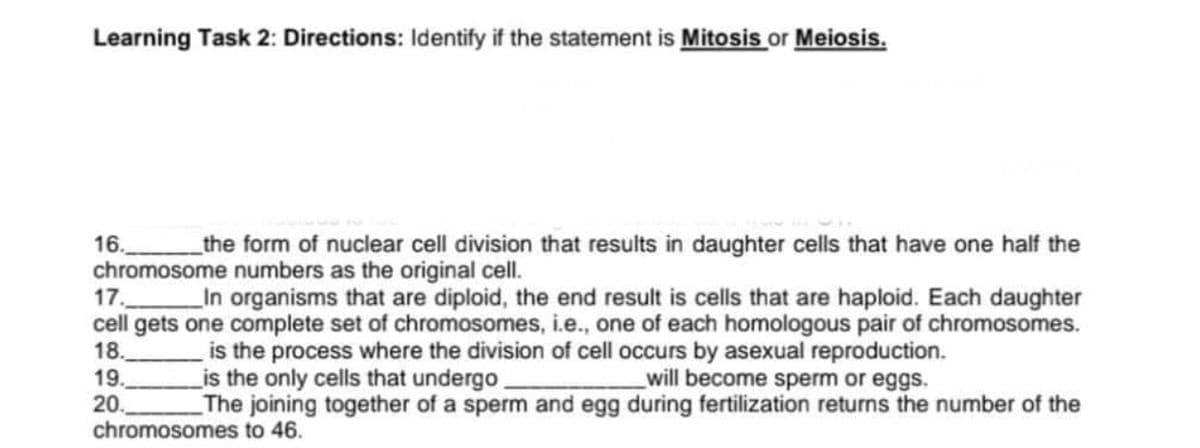_the form of nuclear cell division that results in daughter cells that have one half the romosome numbers as the original cell. In organisms that are diploid, the end result is cells that are haploid. Each daughter Il gets one complete set of chromosomes, i.e., one of each homologous pair of chromosomes. is the process where the division of cell occurs by asexual reproduction. Lis the only cells that undergo, The joining together of a sperm and egg during fertilization returns the number of the will become sperm or eggs. romosomes to 46.
_the form of nuclear cell division that results in daughter cells that have one half the romosome numbers as the original cell. In organisms that are diploid, the end result is cells that are haploid. Each daughter Il gets one complete set of chromosomes, i.e., one of each homologous pair of chromosomes. is the process where the division of cell occurs by asexual reproduction. Lis the only cells that undergo, The joining together of a sperm and egg during fertilization returns the number of the will become sperm or eggs. romosomes to 46.
Biology 2e
2nd Edition
ISBN:9781947172517
Author:Matthew Douglas, Jung Choi, Mary Ann Clark
Publisher:Matthew Douglas, Jung Choi, Mary Ann Clark
Chapter10: Cell Reproduction
Section: Chapter Questions
Problem 1VCQ: Figure 10.6 Which of the following is the correct order of events in mitosis? Sister chromatids line...
Related questions
Concept explainers
Oogenesis
The formation of the ovum (mature female gamete) from undifferentiated germ cells is called oogenesis. This process takes place in the ovaries (female gonads). Oogenesis consists of three stages known as the multiplication phase, growth phase, and maturation phase.
Cell Division
Cell division involves the formation of new daughter cells from the parent cells. It is a part of the cell cycle that takes place in both prokaryotic and eukaryotic organisms. Cell division is required for three main reasons:
Question

Transcribed Image Text:Learning Task 2: Directions: Identify if the statement is Mitosis or Meiosis.
the form of nuclear cell division that results in daughter cells that have one half the
16.
chromosome numbers as the original cell.
17.
cell gets one complete set of chromosomes, i.e., one of each homologous pair of chromosomes.
18.
19.
20.
chromosomes to 46.
In organisms that are diploid, the end result is cells that are haploid. Each daughter
is the process where the division of cell occurs by asexual reproduction.
Lis the only cells that undergo.
The joining together of a sperm and egg during fertilization returns the number of the
will become sperm or eggs.
Expert Solution
This question has been solved!
Explore an expertly crafted, step-by-step solution for a thorough understanding of key concepts.
Step by step
Solved in 2 steps

Knowledge Booster
Learn more about
Need a deep-dive on the concept behind this application? Look no further. Learn more about this topic, biology and related others by exploring similar questions and additional content below.Recommended textbooks for you

Biology 2e
Biology
ISBN:
9781947172517
Author:
Matthew Douglas, Jung Choi, Mary Ann Clark
Publisher:
OpenStax

Concepts of Biology
Biology
ISBN:
9781938168116
Author:
Samantha Fowler, Rebecca Roush, James Wise
Publisher:
OpenStax College

Biology: The Dynamic Science (MindTap Course List)
Biology
ISBN:
9781305389892
Author:
Peter J. Russell, Paul E. Hertz, Beverly McMillan
Publisher:
Cengage Learning

Biology 2e
Biology
ISBN:
9781947172517
Author:
Matthew Douglas, Jung Choi, Mary Ann Clark
Publisher:
OpenStax

Concepts of Biology
Biology
ISBN:
9781938168116
Author:
Samantha Fowler, Rebecca Roush, James Wise
Publisher:
OpenStax College

Biology: The Dynamic Science (MindTap Course List)
Biology
ISBN:
9781305389892
Author:
Peter J. Russell, Paul E. Hertz, Beverly McMillan
Publisher:
Cengage Learning

Anatomy & Physiology
Biology
ISBN:
9781938168130
Author:
Kelly A. Young, James A. Wise, Peter DeSaix, Dean H. Kruse, Brandon Poe, Eddie Johnson, Jody E. Johnson, Oksana Korol, J. Gordon Betts, Mark Womble
Publisher:
OpenStax College

Biology: The Unity and Diversity of Life (MindTap…
Biology
ISBN:
9781337408332
Author:
Cecie Starr, Ralph Taggart, Christine Evers, Lisa Starr
Publisher:
Cengage Learning